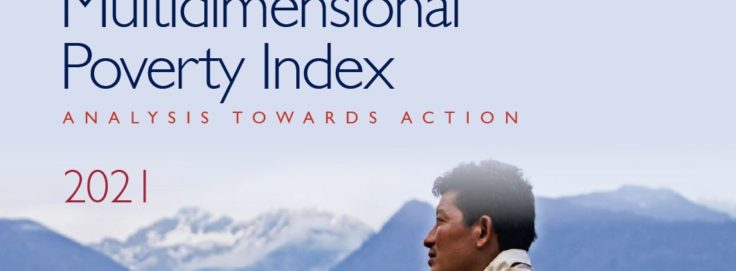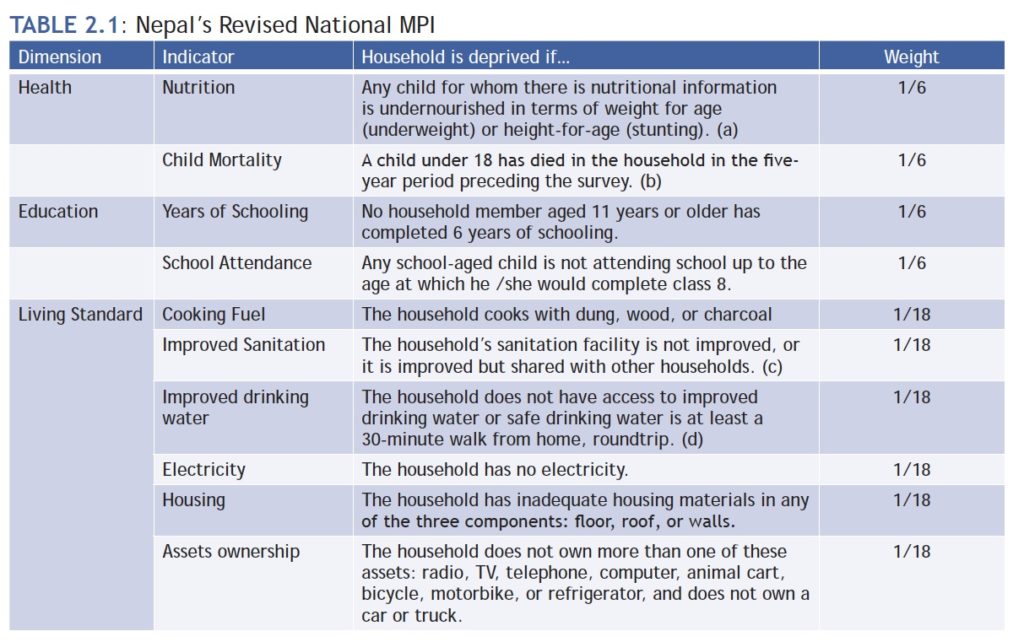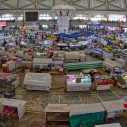
Search
Nepal Multidimensional Poverty Index 2021

The National Planning Commission of Nepal launched today the first update to Nepal’s official national Multidimensional Poverty Index (MPI-NP). In this report, minor adjustments were made to five indicators in 2021 in line with Nepal’s national policy aspirations and to align with the global MPI and Sustainable Development Goals (SDGs) to allow for ongoing international comparability. The five indicators were nutrition, child mortality, years of schooling, housing, and assets.
The results from both measures are similar in terms of the scope of poverty and patterns of its reduction. In 2019, 17.4 percent of Nepalis are multidimensionally poor – just under five million persons, and the MPI is 0.074. Across indicators, the highest number of people are deprived in housing materials, clean cooking fuel, years of schooling, assets, and nutrition.
Considering the indicator weights, years of schooling and nutritional deprivations contribute most to ongoing multidimensional poverty in Nepal.
Disparities exist: for example, 28 percent of rural dwellers are MPI poor, compared with 12.3 percent in urban areas (using the updated definitions of rural and urban zones), and over half of Nepal’s poor population live in rural areas. Across provinces, 39.5 percent of people in Karnali Province are MPI poor – by far the highest – followed by 25.3 percent in Sudurpashchim Province and 24.2 percent in Province 2.
In contrast, in Gandaki Province 9.6 percent of people are multidimensionally poor, while this falls to 7.0 percent in Bagmati Province. However, in terms of number of poor, the largest number live in Province 2, followed by Lumbini Province and Province 1. Children are the poorest – 21.8 percent of children under 18 years of age are MPI poor compared with 15.1 percent of adults. Furthermore, 44 percent of poor people are children under the age of 18, making this group pivotally important for policy. And if the household includes a member with a disability, overall poverty rises to 18.3 percent, versus 17.4 percent otherwise.
In terms of poverty trends, results show strong and equalizing progress in MPI since 2014. Using the new MPI, the incidence of multidimensional poverty nationally fell from 30.1 percent in 2014 to 17.4 percent, and MPI dropped from 0.133 to 0.074, nearing being cut by nearly half in a mere five years. This is a remarkable result, given that the SDG aim is to cut multidimensional poverty by half in fifteen years. In human terms, it means that 3.1 million people left poverty in a mere five years, with only 5 million left to exit. The intensity of multidimensional poverty also significantly decreased from 44.2 percent to 42.5 percent. Nepal’s results are also striking on the international stage in comparison to other countries; according to the 2020 global MPI trend data, no country with a similar starting level of poverty reduced MPI or its incidence faster than Nepal.
How did this change happen? Progress was strong and balanced, in that each of the 10 MPI indicators significantly reduced in that period, with the largest absolute reductions in cooking fuel, sanitation housing, years of schooling, and nutrition. While reductions in cooking fuel and housing deprivations were consistent across all provinces, patterns varied across provinces. For example, Karnali Province showed strong reductions in water deprivations, whereas Provinces 1, 2, and Lumbini Province had outstanding progress in improving sanitation, and Province 2 also made great strides in improving child school attendance and nutrition.
Across provinces and age groups, the patterns of poverty reduction tended to be pro-poor and equalizing. In 2014, Province 2 was the poorest province, whereas by 2019 it was the third poorest. Karnali Province, the second poorest province in 2014, had the second fastest reduction of MPI, followed by Lumbini Province. Across age groups, children reduced poverty faster than adults. Thus, it seems that from 2014 to 2019, the poorest groups were not being left behind but rather were catching up –a positive finding.
Looking forward, it is salutary that in 2019, 60 percent of all poor people would need to reduce just 1-2 deprivations in order to exit poverty, suggesting that further swift reductions would be possible.
However, for moving forward, the findings of the analysis of COVID-19 related deprivations in this report are crucial: First of all, more than half of Nepal’s population (63.5 percent) experience at least one of the COVID-19 related deprivations (Nutrition, Water, Cooking Fuel). Secondly, MPI poor people are more affected by additional COVID-19 related deprivation (overcrowding, internet access, handwashing facilities). Thus, on top of their experiences of overlapping deprivations which already puts them at a disadvantage, the situation of the poor may be more exposed and susceptible to COVID-19 and its consequences.
Source: Nepal Multidimensional Poverty Index 2021. Analysis towards action.

















